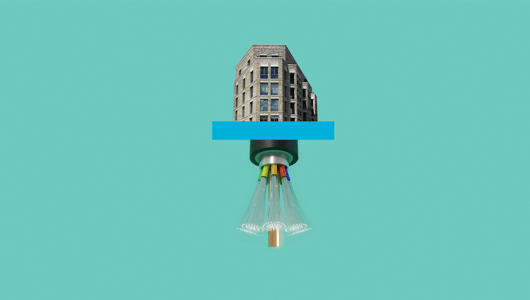How are you reading this blog today? Is it from your laptop in the office (be that work or home) or are you on your smart phone device, whilst on the move?
That you are reading it at all demonstrates a level of digital connectivity we could only dream of a decade ago, yet when it falters the repercussions can be wide.
One of the key factors in ensuring good connectivity is a legal agreement which permits broadband providers to access property to install and maintain their hardware, which enables them to provide a service. These little-discussed legal documents are called wayleaves.
Amidst the complexities of building, fitting out and occupying property, the concept of wayleaves may at first seem a minor detail. Yet, as the UK continues to embrace the digital era, the significance of these legal agreements has grown exponentially. In this blog, Darren Zitren, our head of infrastructure, delves into the small matter of wayleaves and why they play such a big role in facilitating the nation’s digital infrastructure.
Understanding wayleaves
At the core of every wayleave agreement lies a straightforward principle: granting a service provider, such as a telecommunications company or utility provider, the right to access, install, maintain, or repair equipment on land or property. This requirement can be initiated by a developer at the point of build design or by a new occupier struggling to get a good connection, and whilst the idea may sound simple, the process of acquiring the necessary permissions isn’t always straight forward.
The rising demand for digital connectivity
According to a recent Statista report, the number of Internet of Things (IoT) devices worldwide is expected to reach 29 billion by 2030, highlighting the rapid growth and adoption of connected technologies.
As the IoT grows, so does our reliance on a good connection and for many industries, think care homes, Build-to-Rent, logistics and co-working offices, a solid digital infrastructure is at least as important as bricks and mortar, making wayleaves essential for property owners, investors, and developers alike.
The value of a wayleave
If the requirement of a good connection is taken as a given for any commercial or residential property to function in today’s society, then it follows that the value of a building that doesn’t have a good connection will be impacted, particularly if the surrounding buildings do.
Navigating the wayleave process
You can’t have a connected building without a wayleave. Yet despite their obvious benefits, these agreements can be a complex and time-consuming process. Negotiations between landowners and service providers require a thorough understanding of the legal framework, careful assessment of the proposed works, and an acute awareness of the potential impact on the property.
It’s a team thing
Responsibility for ensuring wayleaves are in place can sit in many different roles depending on the size and structure of a company – from the head of IT through to finance director and estate manager. However, our view at Cluttons is that wherever the ultimate responsibility lies, the topic should be discussed around the board table with all the multiple stakeholders included and with one eye on the future … and this is where a property consultancy with decades of experience can add value.
At Cluttons we have successfully agreed thousands of wayleaves in recent years, and are well-equipped to guide clients through the intricacies ensuring a seamless and beneficial experience for all parties involved, ultimately saving you time and money. Furthermore, our team of expert wayleave surveyors can support our clients in managing the relationship with the landlord and/or fibre provider, including agreeing the fibre route and overseeing the build process.
Latest insights

UKREiiF panel: Capacity for Connectivity – Delivering World Class Digital Infrastructure for the UK
The consumer demand for digital connectivity is clear but is the UK investing adequately to enable economic growth? Join us in the debate at UKREiiF.
Net zero doesn’t work without high-quality connectivity
The UK has been at the forefront of the world’s journey to net zero, being one of the first countries to pledge to reach the milestone by 2050.
Connecting today for tomorrow
From future proofing to ESG, we think the conversation around connectivity needs to be moved up the agenda.
How smart are you?
Or to put it another way. How many smart devices did you use/interact with yesterday?
Connecting the UK
We partnered with YouGov to survey MPs and councillors about the Government’s gigabit rollout plans and the challenges involved in meeting the national targets. In addition, we surveyed businesses and consumers to gain insight into the level of understanding around gigabit capable technology and awareness of the benefits that gigabit connections can bring.
5 post-pandemic trends shaping the Central London sales & lettings market
The COVID-19 pandemic led to dramatic changes in how we live and work and has had a huge impact on the UK housing market.
Future office and 5G
The complexities and changes resulting from the pandemic have forced workers to adapt, expectations around working practices have changed rapidly and workplaces must evolve to keep pace.
Understanding connectivity: terminology
The terminology around Connectivity can be tricky to decode. Here our team tells us the most frequently heard terms and explains what they mean.
What is connectivity?
We answer the most commonly asked questions around connectivity.
Cluttons welcomes PM’s commitment to connectivity – but there are significant challenges ahead
Cluttons, the property consultancy and market leading adviser to the largest mobile operators and fixed-line providers, welcomes Boris Johnson’s commitment to making connectivity one of his top five priorities.
A well connected workplace is a win win
In an age where good connectivity has become more important to occupiers than transport links and amenities, digital infrastructure is now a key factor in the decision making process when it comes to taking on a new office space.
Digital infrastructure is key to unlocking performance
In a wide-ranging discussion at today’s London Real Estate Forum, a distinguished panel of experts explored how London’s digital infrastructure is being improved so that it can effectively compete on the global stage.
The commercial connectivity impact report
The majority (65%) of the UK’s commercial landlords have undertaken work to improve the digital connectivity of their buildings, with almost three quarters (72%) of tenants saying that poorly connected offices will become obsolete spaces.
The London connectivity report – part one: residential tenants 2018
Cluttons has published the first part of The London Connectivity Report, focusing on residential tenants, carried out in partnership with YouGov.
